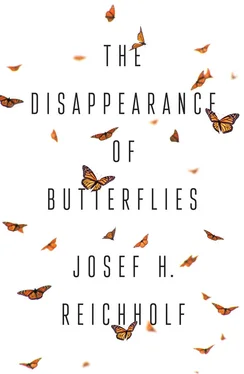In contrast, the ringed china-mark is much harder to detect. Its caterpillars spend their whole lives under water. They do not pass through an air-breathing stage. They do not have to, since they develop thread-like appendages on their bodies, through which the respiratory gas exchange takes place just like in the gills of fish. They are aptly called spiracular gills. Such gills are a very unusual adaptation for moths, although they are normal for the larvae of a very species-rich group of true water insects, the caddis flies. This raises a question that is eminently important for an understanding of the evolution of the Lepidoptera, namely whether spiracular gills are an invention by a genus of aquatic moths, or an ancient legacy linking moths with caddis flies. In other words: are moths and butterflies descended from formerly water-dwelling insects, or early forms of insect that were already established on dry land? There is much to indicate a closer relationship with caddis flies. In any event, they were all ‘born from the water’, just like my little Nymphula .
With a delicate rocking motion, the caterpillars of the ringed china-mark pump water through the loose cocoon, in which they sit under water, eating aquatic plants – in Germany, this is principally water-milfoil, Myriophyllum sp. To do this, they have adapted to survive in warm, oxygen-poor water. In the tropics, these aquatic moths, whose caterpillars develop spiracular gills, have a species-rich network of relationships. However, the non plus ultra of our aquatic moths spends its life as a caterpillar in the depths, among the massive stands of underwater plants that can grow as far as the water surface to flower. It is the tiny water veneer, Acentropus niveus ( Acentria ephemerella ), which the lepidopterists of the nineteenth century did not even recognize as a moth, taking it instead for an unusual species of caddis fly.
The caterpillars of the water veneer moth are comparatively normal. Their bodies are wettable and they breathe through their skin. Small as they are, they do not require a more efficient gas-exchange mechanism. Skin respiration is quite adequate for them, even in the cool and oxygen-rich shallow lakes in which they are principally found. They pupate under water. Yet what emerges from some of the pupae seems barely credible: females whose wings have been shortened to form pointed paddles. With these, they ‘fly’ around under water. Not fast, but fast enough to avoid simply being pushed to the surface. Their hind legs are fringed with a thick row of bristles and they can use these to steer. Stub wings and rudder legs enable these females to achieve goal-oriented movement under water. The reason for this is evident soon after they have emerged from the pupa. They struggle upwards to the water surface, remaining below it, and thrust only the tip of their abdomen out of the water. Glands on that tip will emit a scent that attracts the male with its normal wings.
The males will swoop around just above the water surface as if entranced until they encounter the abdomen tip of a female that is ready to mate. In the course of the coupling, they are almost pulled into the water by the larger female, but their wings prevent them from being dragged down into the deep. When the sperm has been delivered, the male releases the ‘clamp’ with which it gripped the tip of the female’s abdomen. She, in turn, crawls and paddles down and looks around, ‘flying’ and ‘paddling’ until she finds a water plant that is suitable for egg deposition. I have found the caterpillars of this aquatic moth on curled pondweed, Potamogeton crispus , water-milfoil, Myriophyllum sp., and, above all, on Canadian waterweed, Elodea canadensis , which in the 1960s and 1970s was still relatively common in lakes and larger lagoons among the reservoirs along the Lower River Inn.
Having said this, those females with wings adapted to paddling are rare in southern Germany, in contrast to, for example, Denmark, southern Scandinavia and Britain. In central Europe, the females usually develop with normal wings. They are significantly larger than the males – and this is essential. This is because it is only the females, travelling on the wing, even if they are borne and blown along by the air currents rather than by actually flying, that are in a position to find bodies of water in which there are perfectly suitable stocks of underwater plants. The pools found near rivers and reservoirs have existed for too short a time to be considered permanent. However, the much more constant shallow lakes around the Baltic Sea have also only been there since the last ice age, that is, for around 10,000 years. If this aquatic moth had produced only females with rudimentary wings that were unable to fly, this species would surely not have survived in the long term. The males need their flight capability in any event, in order to search for females.
At this point I would like to mention a genetic peculiarity. With butterflies and moths, the female sex is genetically marked XY and the male XX; that is, the exact opposite from us. For this reason, it is much easier for females to develop two different forms than it is for males. This characteristic manifests itself with particular clarity in forms of ‘mimicry’, that is, through the imitation of poisonous or foultasting examples by non-poisonous imitators that are not protected by unpleasant flavours. In short: in moth and butterfly circles, it is worthwhile for the females to be more highly diversified. We can see this clearly with the female of the brimstone butterfly, which resembles the poisonous cabbage whites. The females, with the precious cargo of eggs in their bodies, have good reason to keep themselves concealed. Generally speaking, we therefore see considerably more male butterflies and moths in nature than females.
But let us return to the species composition of the aquatic moths. With their ecological placement on the banks of waterbodies and their lives on and in small bodies of water, they not only provide a prime example of how the species are distributed across their specific habitats (each in their own ‘niche’), but also illustrate why the evolution of all the related adaptations in physique and lifestyle are so rewarding. The water edges constitute an environment rich in plants and luxuriant with plant stock, less affected by the vicissitudes of the weather. Plentiful nutrition is always attractive; plants that are not protected by special toxic substances all the more so. Vegetation right at the water’s edge and, above all, under water, is particularly attractive, not only due to its utility but also because it is situated in a place that the main enemy, the parasitic insects, have difficulties in reaching. The life and survival of any type of moth or butterfly almost always depends on the success of its caterpillars. If the caterpillars do not find sufficient food plants, then that species will not do well. If there is enough food, but the caterpillars feeding on it are heavily parasitized, then the species will not become (more) abundant. One such case is found among those butterflies with caterpillars that eat nettles. Since nettle plants are in plentiful supply, these particular butterflies should also be extraordinarily numerous. They are indeed numerous, but not exceptionally so, and their populations fluctuate from year to year. More of this in a separate chapter that will provide an insight into the nature of fluctuations. With regard to the aquatic moths, there is yet another question: what do they teach us about this general trend, the disappearance of butterflies?
The destruction of the biotopes of the little nymphs
The detailed portrayal of their lifestyle set out above could give the impression that aquatic moths only have such a major role in my book because my research into butterflies and moths started with them. However, they serve as an illustration for the precarious situation in which so many butterflies and moths have ended up. As I shall explain in more detail below, the water-filled gravel pits in which they lived when I carried out my doctoral research no longer exist. They have been buried, filled in. Those that were in the open fields have been reincorporated into agricultural land. They belong to the large group of small structures of which farming land has been ‘cleansed’. In this manner, the aquatic moths and many other butterflies and moths lost the biotopes in which they had flourished for many decades. Dozens of moths and butterflies – and, if one includes the smaller species, surely more than a hundred, as well as hundreds of other insects – made these gravel pits into islands of species diversity at the time when the homogenization of the fields was just beginning. In the opinion of certain influential nature conservationists at the time and of those authorities with jurisdiction over the excavation sites, gravel extraction had to be regulated and concentrated in special cultivation areas that should, of course, be as large as possible. When gravel extraction was complete, they could be repurposed as swimming ponds or, if of largely dry construction, could be recultivated as arable land or woods. It was this same trend that moved away from small- and medium-scale enterprises towards large businesses, and which could simultaneously be seen in agriculture.
Читать дальше












